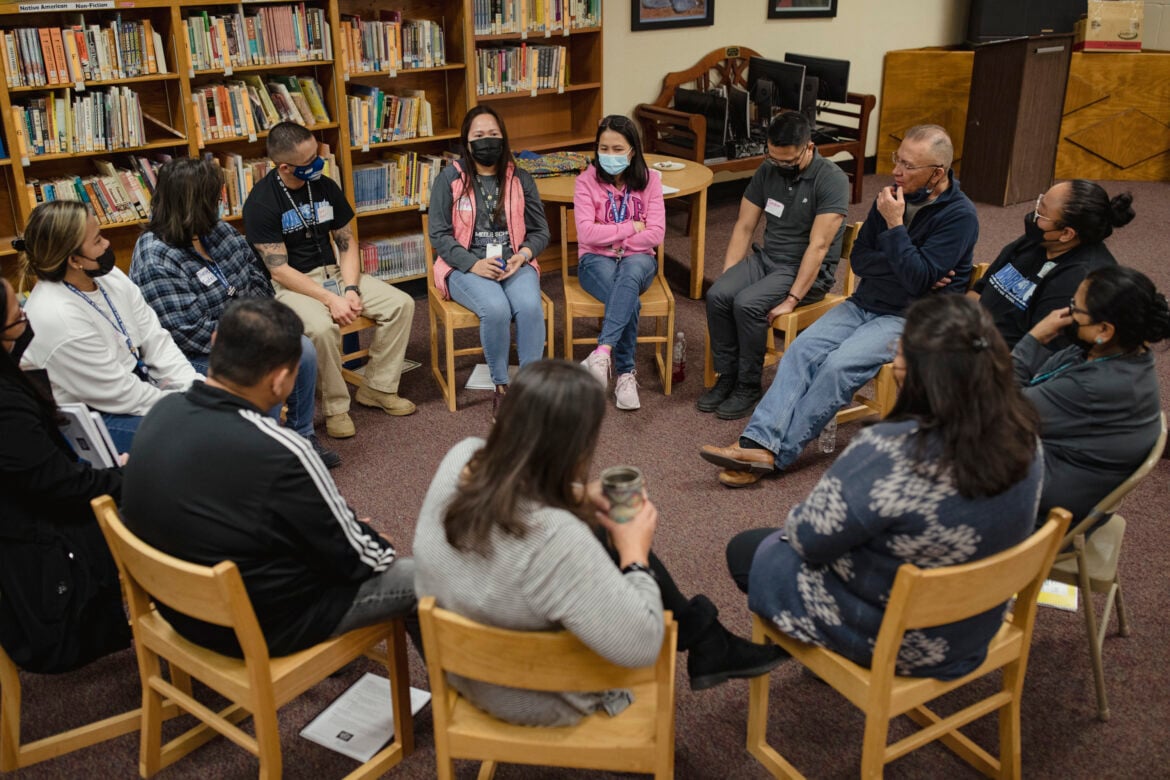On a brisk February morning with snow on the ground, children arrived at Tsé Bit A’í Middle School in Shiprock, on the Navajo Nation in northwestern New Mexico. Word in the hallway was something was afoot: Substitute teachers were waiting in each classroom.
The children’s 35 regular teachers were spotted, sitting in a large circle in the library. Students paused at the doorway to watch.
The teachers, along with school counselors, were training in a new disciplinary approach, often referred to as “restorative justice,” which seeks to rebuild relationships, not simply punish the student who caused the harm. It’s a model New Mexico’s state education department has begun testing with a pilot project in a few other school districts.
Rooted in the belief that everybody has a role to play in addressing harm, restorative justice largely relies on people talking and listening carefully to one another.
“I was raised in circles like this; it’s a traditional practice,” said Principal Pandora Mike, who, like much of the school’s staff and nearly all of its 414 students, is Navajo. “Restorative Justice is about self-regulation, responsible decision making. You really want to help students do a lot of reflection on their own behaviors, their own actions.”
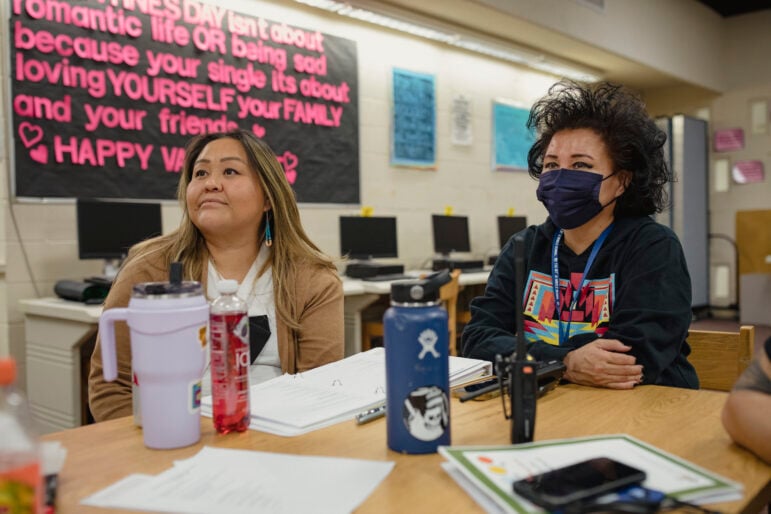
In addition to “circles of sharing,” the program promotes communication through classroom respect agreements to build a greater sense of community among students. When rules are broken, it focuses on mediation. And it seeks to help students understand the root of their misbehavior and how they might do better.
Proponents say it’s a more effective and less harmful disciplinary approach than removing kids from school through long-term suspensions or expulsions, which are tied to lower graduation rates and a higher risk of incarceration.
That’s particularly important for Indigenous students. In New Mexico, Native American students are expelled far more often than any other group and at least four times as often as white students, according to an investigation by New Mexico In Depth and ProPublica.
One school district 90 miles to the south of Tsé Bit A’í, Gallup-McKinley County Schools, is responsible for most of that disparity. Gallup-McKinley has a quarter of New Mexico’s Native students but accounted for at least three-quarters of Native student expulsions in the state during the four school years ending in 2020.
The school district’s expulsion rate was far higher than the rest of the state, according to New Mexico education department records. The district contested that finding, saying some long-term suspensions were mistakenly classified as expulsions. But Gallup-McKinley’s rate of removals from school for 90 days or more, regardless of what they were called, remained far higher than other districts across the state, an analysis by the news outlets confirmed.
While Gallup-McKinley has not embraced restorative justice as an alternative to exclusionary punishments, more than a dozen New Mexico schools have, including some serving Navajo children. Twelve statewide are participating in a new state pilot program, but Tsé Bit A’í and Cuba Independent Schools, both of which serve large Indigenous student populations, initiated the change on their own.
In 2020, leaders from all 23 of New Mexico’s federally recognized tribes called for education reforms, including a shift from harsh discipline and “criminalization of Native children” to restorative justice and peacemaking approaches.
The stakes are high. Expelling and suspending students frequently doesn’t address the underlying problems and can even backfire, making misbehavior more likely, said Daniel Losen. Losen is the director of the Center for Civil Rights Remedies at the University of California, Los Angeles, and senior director of education at the Washington, D.C.-based National Center for Youth Law. He studies racial disparities in school discipline. Pushing children out of classrooms increases the risk of a child dropping out of school or winding up in the criminal justice system, he said.
Students – particularly students of color – are often punished harshly and at higher rates for vaguely defined, catchall minor infractions like disorderly conduct, Losen noted. “That’s where the largest racial disparities are usually found.”
At Gallup-McKinley, for example, disorderly conduct was one of the most frequent reasons for expulsions between the school years 2016-17 to 2019-20, but the term wasn’t even defined in the district’s discipline policy until the 2022-23 school year, after the news organizations asked district officials about this and other facets of student discipline policy. Statewide, Native students were expelled for disorderly conduct at least 76 times and law enforcement was involved in 193 such incidents. About 90% of these incidents occurred in Gallup-McKinley schools.
Overuse of punitive discipline just pushes kids into an adversarial relationship and discourages them, said Tsé Bit A’í Assistant Principal Dannell Yazzie, who is Navajo. Her school is using classroom circles focused on relationship building, Yazzie said, then disciplinary reconciliation circles in the coming school year. She’s put together a team of teachers.
But there are critics.
“Restorative justice means no consequences,” said state Rep. Rod Montoya, a Republican who represents the neighboring town of Farmington, adding that talking circles can disrupt teachers’ instruction time in the classroom. “Teachers are not psychologists.” Montoya said he’s written to school superintendents asking that they not adopt restorative justice practices.
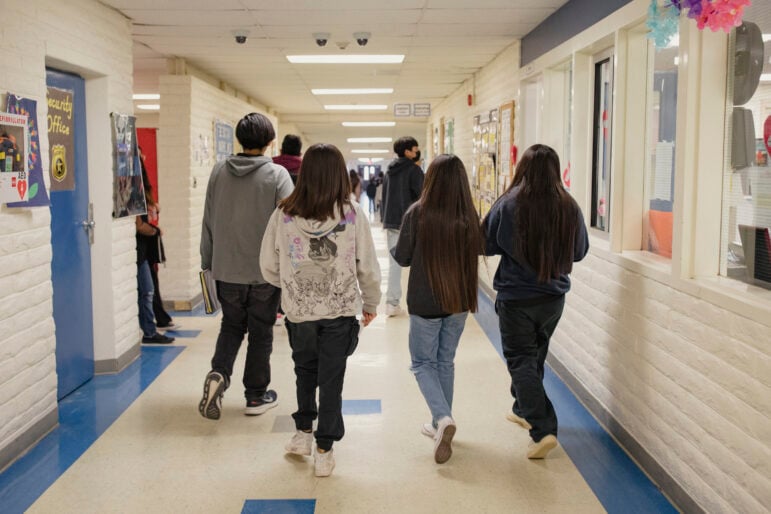
A decade ago, the New Mexico Center for Law and Poverty spotlighted two school districts next to the Navajo Nation for harsh disciplinary practices in a scathing report: Gallup-McKinley County Schools and Cuba Independent Schools district, on the eastern edge of the Navajo Nation.
In the years after, the Cuba school district adopted talking circles as the first response to most student misbehavior but Gallup-McKinley has not. Cuba’s expulsion and out-of-school suspensions have all but disappeared, according to the district’s reports to the state.
Victoria Dominguez, a counselor in Cuba schools, said just holding a talking circle between students or cliques after an altercation can reveal how the school’s rumor mill can cause students to react to falsehoods or misunderstandings without checking to see if they’re true.
The size of circles depends on who is involved and is willing to participate. It might gather a counselor and two students who fought, for example, or larger groups populated by students, family members and teachers.
If students are at odds, Dominguez and their principal will bring them in to talk things out. Problems often stem from misunderstandings, and social media cell phone apps like Snapchat have made things worse, fueling the rumor mill, she said. If a problem persists, they’ll sign non-contact agreements to avoid one another as a cool-down mechanism, or bring in the students’ family members for a talking circle.
“[T]he number of fights has declined significantly with talking circles,” Dominguez said. “It’s been a huge turnaround for the district.”
She doesn’t always wait for an infraction to get kids together to talk. “I’ve pulled kids together to say there’s a rumor circulating that you are going to fight at lunch. We’re doing a mediation circle.”
Cuba has a high population of students who lack secure housing, and who suffer from sleep deprivation and hunger, Dominguez noted. Fostering a culture of communication can help. Sometimes, by asking questions and listening closely, problems at home can be identified and addressed by the district, she said.
“If a teacher’s explaining a really cool math concept but a kid hasn’t eaten in three days or is wearing the same clothes for four or five days, [they are] not going to be able to pick it up,” she said. “In high poverty communities, a lot of times, students are told their truths – they are not given an opportunity to speak their truth, to tell their story from their point of view, uninterrupted. To be heard.”
Cuba district has seen attendance improve since adopting talking circles, she said, with fewer out-of-school suspensions and fewer missed days.
But until recently, just a handful of New Mexico schools in the state used talking circles. So last year, the state Public Education Department announced a $237,500 federally funded pilot program to expand restorative justice in schools, with the goal of reducing suspension and expulsion rates – and ultimately, improve graduation rates.
A dozen schools across the state agreed to have some of their teachers trained and then train their colleagues through the PED pilot program.
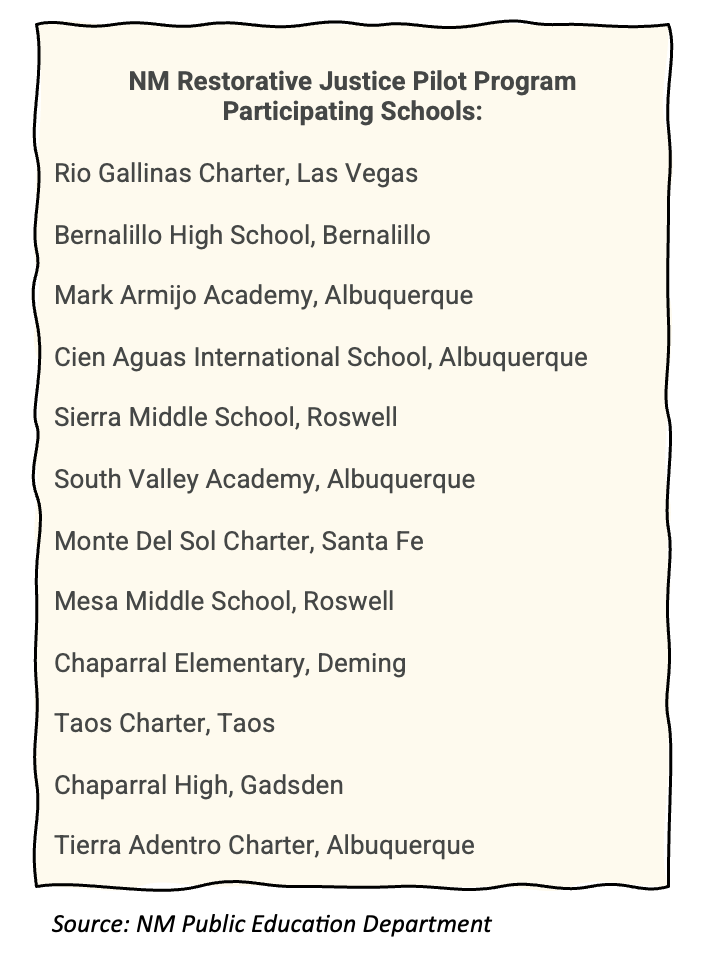
Monte del Sol, a public charter school in Santa Fe, sent two 10th-grade students, a counselor and administrators to the state’s training. The 10th-graders facilitated the school’s first disciplinary remediation circle, with two groups of 8th grade girls.
It didn’t bring an immediate breakthrough, but Amy Garcia, one of the student facilitators, said it was a good start. “Not everybody is super comfortable with talking about how they feel,” Garcia said. “We did come to an agreement where they would at least give each other their space.”
Restorative justice proponents like Emma Green, who runs the state’s pilot program, see student misbehavior as a red flag that something’s wrong in a child’s life, and an opportunity for constructive intervention – to discover the underlying problem, mediate and help the child take responsibility for how they’ve affected others, and to connect the child to needed support.
But student support services are in very short supply in much of the state, skeptics point out. They question whether restorative justice will work across the state.
Making a student who has been victimized sit down with the student who bullied or victimized them can retraumatize that child, Montoya said.
When he asked the state public education department whether talking circles would be used even in cases of bullying or physical violence, he was told that is up to individual school districts, which have wide latitude in setting discipline policies.
Restorative justice facilitator Randy Compton, from Boulder, Colorado, said talking circles won’t resolve every problem. With a case of mild bullying, a talking circle might be appropriate, he said, “but at the extreme end, a child who bullies others will often just manipulate the process. In those cases, you would not necessarily want to put the child and the student who bullied them in a talking circle.”
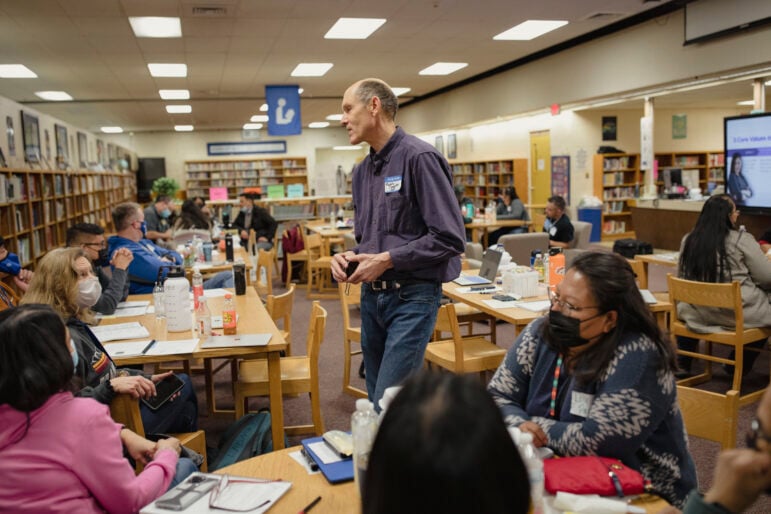
In addition to trainings at Tsé Bit A’í Middle and Shiprock High School, Compton also has trained staff at Albuquerque Public Schools and the Aztec, N.M. school district, and schools across the U.S.
At Tsé Bit A’í, assault, drug and tobacco offenses still will automatically involve out-of-school suspensions, Yazzie said. Upon their return to school, students will attend counseling interventions to discuss their behavior and how it impacted others.
“People think we just sit in a circle and sing Kumbaya, but it’s not like that,” she said. “It’s not without consequences. And we will discuss why children behave in a certain way. It needs to be both. We’re providing them with an opportunity to learn and think about their behavior.”
Tsé Bit A’í is adopting restorative justice practices in stages, Yazzie said.
From initial training sessions to successful implementation, programs typically require three to five years to become a smoothly operating part of a school’s discipline culture, Compton said.
But that can be a challenge in New Mexico, where schools struggle with staff turnover. Teachers and administrators come and go frequently. Just as a school begins to make progress, trained staff and organizers will move away, and their replacements must then be convinced to invest their time and energy into learning an unfamiliar approach to student discipline.
Ultimately, university teacher training programs will have to make restorative justice part of their regular curriculum so that newly arriving teachers already understand the concepts and practices involved, Yazzie said.
“The [college] textbooks definitely do not teach this,” Dominguez agreed.
For now, it’s up to schools and districts.
Green echoed Yazzie’s point that restorative justice is not about abandoning consequences for student misbehavior.
“Letting people off the hook is absolutely not restorative,” she said. “The foundation and the heartbeat of restorative justice is accountability.”
